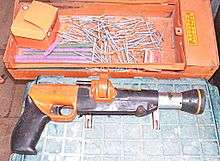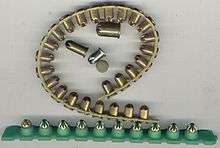Powder-actuated tool

A powder-actuated tool (often generically called a "Hilti gun" or a "Ramset gun" after their manufacturing companies) is a type of nail gun used in construction and manufacturing to join materials to hard substrates such as steel and concrete. Known as direct fastening, this technology relies on a controlled explosion created by small chemical propellant charge, similar to the process that discharges a firearm.
Powder-actuated tools come in either high velocity or low velocity types. In high velocity tools the propellant charge acts directly on the fastener. This process is similar to a firearm. Low velocity tools introduce a piston into the chamber. The propellant acts on the piston, which then drives the fastener into the substrate. (The piston is analogous to the bolt of a captive bolt pistol.) A powder-actuated tool is considered to be low velocity if the average test velocity of the fastener does not exceed 492 feet per second (150 m/s). High velocity tools may not be made or sold in the United States, however some made decades ago are still in use in shipbuilding and steel industries. The main manufacturers of powder actuated tools are Ramset, Hilti, Powers/Dewalt, Tomarco and Simpson Strong Tie.
Powder-actuated fasteners are made of special heat treated steel. Common nails should never be used for powder-actuated fastenings. There are many specialized fasteners designed for specific applications in the construction and manufacturing industries.
Powder-actuated technology was developed for commercial use during the Second World War, when high velocity fastening systems were used to temporarily repair damage to ships. In the case of hull breach, these tools fastened steel plates over damaged areas.[1] These tools were developed by Mine Safety Appliances, for the United States Navy.[2] Powder-actuated tools were investigated and used prior to this development; they were used as part of submarine hunting during the First World War and were the subject of a 1921 United States patent (US Patent No. 1365869).[3]
Use

Fasteners take various forms, for example with threaded ends to use as an embedded bolt, with washers at the tips that grip softer material etc. Fasteners used in powder-actuated tools are manufactured from special steel and heat-treated to produce a very hard yet ductile fastener. Those properties are necessary for the fastener to penetrate concrete or steel without breaking.
Operation

Powder-actuated tool cartridges are specially-designed blank firearm cartridges. In many cases, the charges are ordinary firearm cartridges with modified casings, and the bullet removed. The .22 Short, developed by Smith & Wesson is common. These charges may be hand-fed, or manufactured and distributed on a plastic strip. The charges are activated when a firing pin strikes the primer, which is an explosive charge in the base of cartridge. The primer ignites the charge, which burns rapidly. The gases released by the burning of the propellant build pressure within the cartridge, which acts either on the head of the nail, or on the piston, accelerating the nail towards the muzzle.
Powder actuated tools can be variously classified:
- Direct acting (the charge acts directly on the head of the nail or high velocity), or indirect (using an intermediate piston or low velocity)
- Single-shot, or magazine-fed
- Automatic or manual piston cycling
- Automatic or manual feed of the charges
Color coding:
Color-coding for the "rounds" or "single shots" (the three shot strengths or colors typically sold to the general public are brown, green and yellow in brass):
| Color coding | Velocity |
|---|---|
| Grey | 315 ft/s (96 m/s) |
| Brown | 385 ft/s (117 m/s) |
| Green | 490 ft/s (150 m/s) |
| Yellow | 575 ft/s (175 m/s) |
| Red | 675 ft/s (206 m/s) |
| Purple | 755 ft/s (230 m/s) |
| Color coding | Velocity |
|---|---|
| Grey | 845 ft/s (258 m/s) |
| Brown | 935 ft/s (285 m/s) |
| Green | 1,025 ft/s (312 m/s) |
| Yellow | 1,115 ft/s (340 m/s) |
| Red | 1,205 ft/s (367 m/s) |
| Purple | 1,295 ft/s (395 m/s) |
Not all powder-actuated tools are rated for high capacity charges — the strongest charge (nickel - purple @ 1,295 ft/s (395 m/s)), for example, is dangerous in a tool not rated for its use. Above is for a 350 grain slug from a test device.
Safety
As with their air-actuated cousins, powder-actuated guns have a muzzle safety interlock. If the muzzle is not pressed against a surface with sufficient force, the firing pin is blocked and cannot reach the load to fire it. This ensures that the gun does not discharge in an unsafe manner, causing the nail to become a projectile. Nonetheless, good judgment should always be used when using a powder-actuated nail gun, since the nail is driven with far more force than an air-actuated gun. The surface being nailed should, therefore, certainly be capable of stopping and holding the nail.
Most manufacturers of powder-actuated nail guns offer training and certification. Many projects and employers require this before an employee is permitted to use the tool.
The ownership and use of these tools is regulated in Australia. The owner has to register the tool, and an operator of one of these tools is required to have a license and to have undergone training in their use. These laws are in keeping with Australia's extremely strict firearm laws.
In the US, failure to properly dispose of charges is a common OSHA safety violation. Training is required before someone can use the tool on a jobsite.
Powder-actuated fasteners
Fasteners used in powder-actuated tools are not common nails. They are manufactured from special steel and heat-treated to produce a very hard yet ductile fastener. These properties permit the fastener to penetrate concrete or steel without breaking. A powder-actuated fastening results in a permanently installed fixture. Every fastener must be equipped with some type of tip, washer, eyelet or other guide member. This guide member aligns the fastener in the tool as it is being driven and is commonly used to retain the fastener in the tool. Common nails are not suitable for powder actuated fastening.
Common fasteners
There are two common powder-actuated fasteners: drive pins and threaded studs.
- Drive Pin - A drive pin is a special nail-like fastener designed to permanently attach one material to another, such as wood to concrete or wood to steel. Head diameters vary in size from 1/4" to 3/8". However, for additional head bearing in conjunction with soft materials, washers, of larger diameters are either fastened through or made part of the drive pin assembly.
- Threaded Stud - A threaded stud is a fastener consisting of a shank portion which is driven into the base material (and is therefore not visible after fastening) and a threaded portion (which remains visible after the fastening). An object is then attached to the threaded portion with a nut. The most common thread sizes are 1/4-20, and 3/8-16.
Fasteners for special applications
There are also other types of fastener assemblies designed for specific applications. Examples include:
- Breakaway Fasteners - For temporary fastening of wood forming to concrete, designed to break away after forms are removed.
- Weathered Fasteners - Typically used to attach lumber to steel or concrete.
- Magazine Fasteners - These are collated fasteners for magazine fed tools.
- Steel Deck Fasteners - Used to attach corrugated metal deck to bar joist or I-beam.
- Conduit Clips - Used to attach EMT conduit to concrete, masonry or steel.
- Ceiling Clips - Typically used by ceiling contractors.
- Road Basket Clips - Used to secure re-bar baskets in highway construction and paving.
See also
References
- ↑ "Engineering maintenance". Hospital Management. Clissold Publishing Co. 90: 52. 1960.
- ↑ "Powder-actuated driver". The Signalman's journal. Brotherhood of railroad signalmen of America. 29–30. 1948.
- ↑ "Powder-actuated fasteners". Engineering journal. American Institute of Steel Construction. 40–41: 99. 2003.